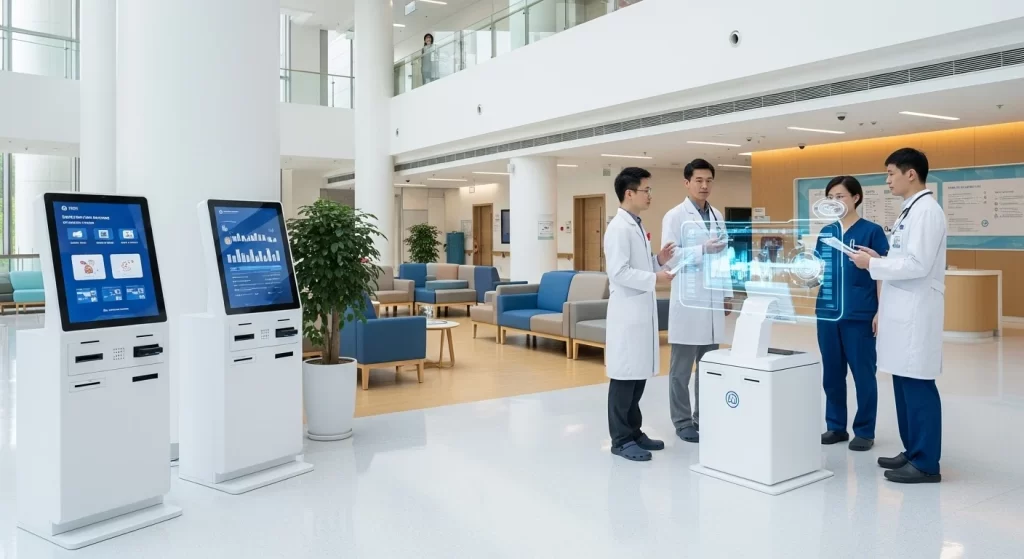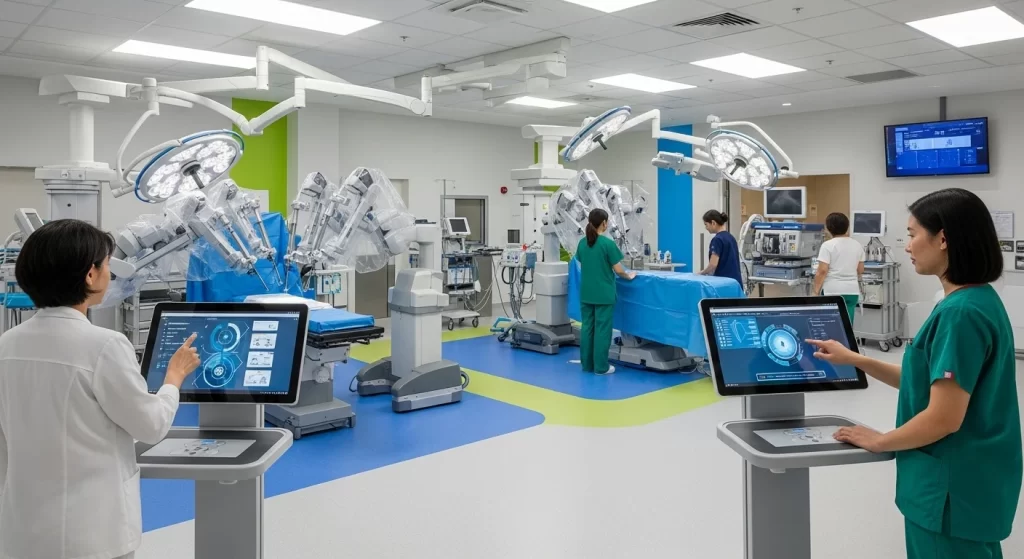The healthcare landscape is on the cusp of a profound transformation, driven by the accelerating capabilities of artificial intelligence (AI). The concept of the “AI hospital” is rapidly moving from futuristic vision to tangible reality, promising to reshape nearly every facet of patient care and hospital operations. This evolution signifies a fundamental shift towards a more intelligent, efficient, and personalized healthcare ecosystem. This article delves into the multifaceted world of AI hospitals, exploring their core concepts, real-world applications, underlying technologies, and the critical considerations for their successful implementation.

The journey towards the AI hospital is complex but filled with opportunity. At SPsoft, we are committed to developing innovative software solutions that empower healthcare organizations to harness the power of AI responsibly and effectively. Our expertise in creating intelligent, secure, and interoperable platforms can help you navigate the intricacies of AI integration, from optimizing workflows to enabling advanced analytics. We believe in a future where technology and human compassion work hand-in-hand to deliver exceptional care.
Ready to embrace the future of healthcare services? SPsoft has vast experience in developing and integrating AI solutions for hospitals and other medical settings!
The Dawn of Intelligent Healthcare: Introducing the AI Hospital
The emergence of the AI hospital signals a paradigm shift in medical practice, moving beyond simple automation to a future where human expertise is powerfully augmented by intelligent systems.
An AI hospital represents a fundamental reimagining of how healthcare is delivered, where artificial intelligence is intricately woven into clinical, operational, and patient-facing processes. It’s an environment where AI not only assists but actively augments human capabilities, enabling healthcare systems to “think, act, and interact smarter, quicker, and more efficiently.” This vision moves beyond discrete AI tools towards a holistic, integrated system.
Traditional hospitals rely heavily on manual processes and sequential decision-making, which can lead to delays and inefficiencies. AI hospitals aim to transcend these limitations by leveraging data-driven insights and intelligent automation. The ultimate vision is a synergistic healthcare ecosystem where the nuanced expertise of human professionals combines with the analytical power of AI, fostering proactive, personalized, and efficient patient care.
Core Technologies Powering the AI Hospital
The AI hospital is built upon a suite of sophisticated technologies:
- Machine Learning (ML). The engine driving predictive analytics, advanced diagnostics, and personalized medicine. ML algorithms learn from vast datasets (EHRs, medical imaging, genomic sequences) to identify patterns, predict risks, and suggest interventions.
- Natural Language Processing (NLP). Enables AI to understand and generate human language, crucial for analyzing clinicians’ notes, powering patient communication systems like chatbots, and extracting insights from text-based records.
- Computer Vision. Empowers AI to interpret medical images (X-rays, CT scans, MRIs) with remarkable accuracy, aiding in early disease detection and reducing diagnostic workloads.
- Robotics. AI-integrated robotics transforms areas from precise robot-assisted surgeries and automated lab processes to direct patient care and logistical tasks.
The synergistic effect of these technologies is critical, with future advancements likely focusing on integrated solutions.
Key Applications and Benefits of AI in Hospitals
AI integration is enhancing diagnostics, personalizing medicine, optimizing operations, and improving patient experiences.
Smarter Diagnostics and Personalized Medicine
AI excels at analyzing complex medical data to detect diseases like cancer or sepsis with greater speed and accuracy. It can identify subtle patterns indicative of early-stage disease, often before symptoms are apparent. Moving beyond one-size-fits-all approaches, AI enables customized treatment plans by analyzing a patient’s unique genetic makeup, clinical history, and lifestyle factors. This personalization aims to maximize efficacy and minimize side effects. Furthermore, AI is used to identify individuals at high risk for developing specific conditions, allowing for proactive interventions and preventative care strategies.
Optimizing Hospital Operations
AI is invaluable in streamlining hospital workflows, leading to gains in efficiency and resource utilization, which can alleviate workforce shortages and reduce administrative burdens. AI automates tasks like appointment scheduling, patient triage, medical billing, and EHR management. For instance, AI-driven billing systems have been shown to reduce errors significantly. Efficient management of resources such as beds, operating rooms, and staff is critical.
AI algorithms analyze data to predict patient admission rates and optimize scheduling, reducing wait times. In critical care settings like ICUs, AI systems provide continuous patient monitoring, detecting subtle changes indicative of deterioration earlier than human observation alone. AI-powered predictive maintenance for medical equipment forecasts needs before breakdowns occur, reducing downtime and enhancing safety. AI also optimizes inventory and supply chain management by forecasting demand and automating reordering.
Enhancing Patient Experience and Engagement
AI is creating a more patient-centric healthcare experience. AI-driven tools like chatbots and automated messaging provide timely, personalized information, answer FAQs, and offer appointment reminders. By optimizing scheduling and patient flow, AI contributes to shorter wait times. AI can also tailor the healthcare experience with personalized educational materials and follow-up care plans.
The Role of Robotics in Clinical Settings
AI-powered robotics extends the capabilities of healthcare teams. Robot-assisted surgery enhances precision for minimally invasive procedures, leading to shorter hospital stays. Beyond surgery, robots assist with medication dispensing, vital sign monitoring, and patient mobility. Autonomous mobile robots handle logistical tasks like transporting supplies and performing automated cleaning, improving efficiency and reducing infection risks.
AI Hospitals in Practice: Global Pioneers and Real-World Impact
Real-world AI implementations offer insights into its practical application.
China’s “Agent Hospital” – A Virtual Proving Ground
A pioneering initiative is the “Agent Hospital” by Tsinghua University in China, a virtual ecosystem where AI “doctors” and “nurses” diagnose and treat virtual patients. These AI agents reportedly simulated treating over 10,000 virtual patients in days, achieving high accuracy on medical benchmarks. This China AI hospital simulation serves to train medical professionals and allows AI models to continuously learn. While virtual, it’s reportedly nearing practical application, potentially revolutionizing AI validation and medical education.
Other Noteworthy Implementations and Pilot Programs Worldwide
Tangible AI applications are emerging globally. Synyi AI launched a pilot “Dr. Hua” clinic in Saudi Arabia where an AI “doctor” autonomously conducts diagnostic consultations for common respiratory conditions, with human physician oversight. In the United States, many hospitals use AI or predictive models integrated with EHRs, primarily for predicting inpatient health trajectories and identifying high-risk outpatients.
Early adopters like Mayo Clinic are pursuing AI, but many are cautious due to concerns about technology maturity, data infrastructure, and cybersecurity. China is a significant hub for AI in healthcare. Huashan Hospital uses an AI multimodal diagnostic system for lung nodules. South China Hospital in Shenzhen employs AI to assist urologists with clinical evidence retrieval. Shanghai Fourth People’s Hospital uses AI-generated medical record templates. These examples from China AI hospital settings and elsewhere underscore a strong commitment to integrating AI. Ping An Good Doctor in China offers AI-assisted health consultations. These initiatives show that while fully AI-run hospitals are still aspirational, practical AI applications are delivering benefits.
Table 1. Overview of Key AI Hospital Initiatives
| Initiative / Hospital Name | Location | Key AI Technologies Used | Primary Focus Area(s) | Status / Scale | Reported Outcomes / Key Learnings |
|---|---|---|---|---|---|
| Agent Hospital | China | LLMs, ML | Virtual patient treatment, AI training, Medical simulation | Virtual simulation, nearing practical application | 93.06% diagnostic accuracy (virtual, MedQA), Simulates 10,000 patients in days |
| Synyi AI “Dr. Hua” Clinic | Saudi Arabia | ML, NLP | Autonomous diagnosis (supervised), Respiratory conditions | Pilot program with real patients | Focus on ~30 respiratory conditions, 18-month regulatory approval aim |
| US Hospitals (Aggregate) | USA | ML, Predictive Models | Predictive analytics, High-risk patient ID, Scheduling | Widespread EHR integration (65% of hospitals) | 92% use for inpatient risk, 79% for high-risk outpatient ID |
| Huashan Hospital | China | AI, Computer Vision | Multimodal lung nodule differentiation | Specific departmental use | 95.2% diagnostic accuracy reported |
| Beijing’s National Cancer Center | China | Deep Learning, CV | Cancer diagnosis from medical imaging | Research & Clinical Application | 89% diagnostic accuracy vs. 73% for human radiologists in a study |
| Shanghai Fourth People’s Hospital | China | AI, NLP | Automated medical record document-ion | Operational Integration | AI completes ~80% of document-ion |
Navigating the Transformation: Challenges and Strategic Considerations
The path to widespread AI hospital implementation involves technological, organizational, economic, ethical, and regulatory challenges.

Overcoming Technological and Infrastructural Hurdles
AI systems require modern, secure, and scalable IT infrastructure capable of managing vast data volumes. Interoperability—seamless data flow between AI tools and legacy systems — is critical. Protecting sensitive patient data from cyber threats is paramount. The accuracy and reliability of AI models must be rigorously validated, especially across diverse patient populations, as models trained on specific datasets may not generalize well. The cost of AI implementation, including software, hardware, infrastructure upgrades, and expertise, can be a considerable barrier.
The Human Factor: Workforce Evolution, Upskilling, and Training
AI integration necessitates an evolution in the healthcare workforce. Staff must be trained to use AI tools, interpret outputs, and understand limitations. AI is expected to transform roles by automating routine tasks, allowing professionals to focus on complex decision-making and empathetic patient care. AI itself can enhance medical education through personalized learning paths and VR simulations. Effective change management and clear communication are crucial to overcome resistance and foster a culture that embraces innovation.
Economic Viability: Assessing the Cost-Effectiveness and ROI of AI in Hospitals
While initial investments are substantial, AI offers potential for long-term cost savings. Wider AI adoption could save 5 to 10 percent of total US healthcare spending. Some analyses suggest AI could reduce specific patient care costs significantly and cut annual US healthcare costs by billions.
Sources of these savings include:
- Reduced medical errors, avoiding costly complications.
- Optimized staffing and operations, leading to efficient resource use.
- Lower administrative costs through automation.
- Fewer hospital readmissions via predictive analytics.
- Waste reduction through optimized inventory and diagnostics. Beyond direct savings, AI offers non-financial returns like improved care quality, patient access, and clinician satisfaction.
Building a Framework of Trust: Ethical, Legal, and Regulatory Landscapes
The transformative power of AI in healthcare is accompanied by profound ethical, legal, and regulatory questions.
Addressing Liability and Medical Malpractice in AI-Driven Healthcare
When AI systems are involved in clinical errors, determining responsibility is complex. Was it the physician, the hospital, or the AI developer? The “black box” nature of some algorithms, where decision-making processes are opaque, further complicates liability.
Potential liable parties include:
- Healthcare Providers and Hospitals. For negligent reliance on AI or failure to implement verified AI or proper oversight.
- AI Developers and Companies. If algorithms are flawed or trained on biased data.
- Shared Responsibility Models. Distributing liability based on respective roles.
Data Governance and Patient Privacy in the AI Era (HIPAA, GDPR)
AI systems process vast quantities of sensitive patient information, making robust data governance and privacy adherence non-negotiable. The World Health Organization (WHO) notes that traditional anonymization is often less effective with large, complex datasets. Compliance with regulations like HIPAA (US) and GDPR (EU) is essential. GDPR classifies health data as a “special category” requiring enhanced protections.
Key governance practices include:
- Establishing clear policies for data access, use, sharing, and disposal.
- Employing strong encryption and pseudonymization.
- Conducting regular privacy impact and security risk assessments.
- Providing thorough staff training on data privacy.
- Managing third-party vendor risks.
- Maintaining detailed audit trails.
The Evolving Web of AI Healthcare Regulations and Global Standards (FDA, WHO)
The regulatory landscape for AI in healthcare is still developing. In the US, the FDA regulates AI tools qualifying as medical devices. The WHO provides global guidance on AI for health, emphasizing ethical principles, governance, and best practices, including ensuring equity, data protection, transparency, and accountability. Various jurisdictions are introducing AI-specific legislation, such as federal proposals in the US and state-level acts like the Colorado Artificial Intelligence Act.
Tackling Bias, Ensuring Transparency, and Upholding Patient Consent
Ethical AI application is paramount. Algorithmic bias is a significant concern; if AI is trained on unrepresentative data, it may perpetuate health disparities. Mitigating bias requires careful attention to data sourcing and model monitoring. Transparency and explainability, while challenging with complex models, are ethically important for building trust. Patients have the right to informed consent, knowing when AI is used in their care, its potential benefits and risks, and how their data will be used. Ethical AI must protect patient autonomy and ensure human clinicians retain ultimate oversight in critical decisions.
The AI in Healthcare Market: Growth, Trends, and Investment Outlook
The AI in healthcare market is expanding rapidly, driven by the need for more efficient and accessible healthcare.
Market Size, Projections, and Key Growth Drivers
The global AI in healthcare market was valued around $20.9-$22.45 billion in 2023-2024 and is projected to surge to over $148-$164 billion by 2029-2030, with a high compound annual growth rate (CAGR).
Key market segments showing strong growth include:
- Drug Discovery
- Robot-Assisted Surgery
- Virtual Assistants and Chatbots
- Generative AI in Medicine
- Precision Medicine North America currently leads the market, but significant growth is anticipated in regions like China. Investor confidence is strong, with AI-based digital health startups receiving a growing share of funding. This growth is driven by the need to reduce costs, improve operational efficiency, and manage aging populations.
Insights from Industry Leaders
Analysts like Gartner emphasize practical AI applications that improve outcomes and patient service. They stress matching AI capabilities to specific healthcare challenges and ensuring solutions are safe and scalable. Gartner’s Hype Cycle for Healthcare Data, Analytics and AI helps leaders make informed investment decisions by showing technology maturity. There’s a strong focus on generative AI, signaling a new frontier beyond traditional predictive analytics towards AI creating novel content like drug candidates or personalized patient materials.
Table 2. AI in Healthcare Market Snapshot
| Market Indicator | Data/Trend |
|---|---|
| Overall Market Size (2023/24) | ~$20.9B – $22.45B |
| Projected Market Size (2029/30) | ~$148B – $164.12B |
| Overall Market CAGR (2024-30) | ~36.4% |
| Key Market Segments | Drug Discovery, Robot-Assisted Surgery, Virtual Assistants, Generative AI, Diagnostics, Operational AI |
| Leading Regions (Current) | North America (59.1%), Europe (20.3%), Asia-Pacific (15.2%) |
| High-Growth Region (Future) | China (projected 40% revenue growth 2023-2030 in AI medicine) |
| Key Growth Drivers | Need for efficiency, Cost reduction, Aging population, Big data availability, Technological advancements |
| Major Investment Areas | Generative AI, AI-based digital health startups, Drug discovery, Predictive analytics |
The Future is Intelligent: Charting the Course for AI Hospitals
The future of AI in healthcare points towards intelligent systems as integral components of care, enhancing human capabilities and fostering responsible healthcare.

Expert Visions: Augmentation, Collaboration, and the Future Physician
Experts believe AI’s primary role will be to augment, not replace, human healthcare professionals. The American Medical Association (AMA) suggests physicians effectively using AI may gain an advantage. AI is expected to enhance diagnostics, streamline workflows, and provide decision support. By automating administrative tasks, AI can free clinicians for more quality patient time, fostering deeper engagement. AI may also enable new care models, like teaming nurse practitioners with AI decision-support tools to expand access.
Next-Generation AI: Emerging Innovations and Their Potential
Several emerging AI innovations hold promise:
- Advanced Large Language Models (LLMs). Continued advancement of LLMs, as seen in concepts like China’s “Agent Hospital,” is predicted to fundamentally reshape medicine, offering nuanced understanding and reasoning.
- Multimodal AI. Systems that process and integrate diverse data types (text, images, voice, genomic data) mirror how human doctors synthesize information.
- Edge AI. Processing AI algorithms locally on medical devices for real-time applications like robotic surgery or continuous patient monitoring, enhancing speed and data privacy.
- AI in Sustainability. Optimizing energy consumption, waste management, and resource utilization in hospitals for greener healthcare.
Pathways to Responsible and Equitable Adoption
Realizing AI’s potential requires commitment to responsible innovation:
- Co-design with Humans. Involving healthcare workers and patients in AI system design ensures practicality and user-friendliness.
- Addressing the Digital Divide and Equity. Ensuring AI benefits are accessible to all populations and don’t exacerbate disparities, requiring diverse training data and deployment in underserved areas.
- Strategic Roadmaps and Pilot Projects. Creating clear AI adoption roadmaps, often starting with pilot projects to evaluate benefits and manage risks.
- Collaboration. Strong partnerships between healthcare organizations, AI vendors, academic institutions, and regulatory bodies are crucial. Robust AI governance frameworks, ethical review boards, and continuous monitoring for fairness are essential before widespread deployment.
Conclusion
The journey towards the AI hospital, while complex, promises to redefine healthcare for the better. Artificial intelligence is poised to deliver transformative benefits, including enhanced diagnostics, streamlined operations, personalized treatments, and improved patient outcomes. While challenges exist, they can be overcome through strategic planning, ethical commitment, robust data governance, workforce development, and collaborative innovation. The AI hospital is an evolving reality.
The future of healthcare will be intelligent. The key lies in harnessing AI as a powerful augmentative force that empowers clinicians, optimizes systems, and centers care around the patient in a smarter, more responsive, and humane ecosystem.
Our AI solutions are designed to increase efficiency, improve patient outcomes, and support your team. Contact us to learn how we can help you thrive!
FAQ
What is an AI hospital?
An AI hospital deeply integrates AI technologies across its clinical, operational, and patient-facing processes to enhance efficiency, diagnostic accuracy, personalize treatment, and elevate patient outcomes by augmenting human capabilities.
Will AI replace doctors and nurses?
The consensus is that AI will augment, not replace, healthcare professionals. AI will automate routine tasks and provide decision support, allowing clinicians to focus on complex patient care and empathy.
What are the main benefits of AI in hospitals?
Key benefits include faster, more accurate diagnoses; personalized treatment plans; optimized operations leading to reduced wait times; an improved patient experience; and potential long-term cost savings.
Are there fully AI-run hospitals today?
No, there are no hospitals fully run by AI treating real patients without human oversight. Virtual simulations like China’s “Agent Hospital” exist for training, and pilot programs explore AI-led diagnosis under strict human supervision.
What are the biggest challenges in implementing AI in hospitals?
Major challenges include high upfront costs, data interoperability, cybersecurity risks, validating AI model accuracy and mitigating bias, staff training, and navigating complex ethical and legal landscapes.
How is patient data protected in an AI hospital?
Protection involves robust data governance, compliance with regulations like HIPAA and GDPR, technical safeguards (encryption, access controls), regular risk assessments, and staff training.
What types of AI are used in hospitals?
Common types include Machine Learning (ML) for predictive analytics, Natural Language Processing (NLP) for understanding clinical notes, Computer Vision for analyzing medical images, and AI Robotics for surgery and patient assistance.



